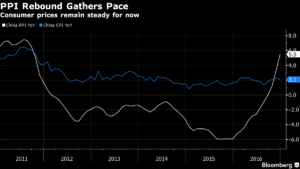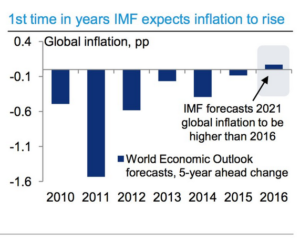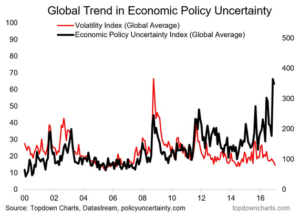The ample availability of competent and cheap workforce has made India the global ‘outsourcing destination of choice’ in sectors such as IT, pharma, Gems and Jewellery, financial services etc. However, with right winged nationalist ideologies gaining prominence globally, this could come under some serious threat. The Republicans in the House of Representatives with the backing of President elect Donald Trump, have proposed changes to the US corporate tax code which could mark one of the most important shifts in US tax and international trade policy in a generation and an underappreciated threat to Indian exports. The so called “border adjusted” plan could radically change the structure of business taxation by imposing a 20 percent tax on all imports by US and providing a special exemption for all export-related income.
I will come to the potential impact but consider these facts:
Trump’s threat to protect the US interest in an inward-looking manner looks increasingly real now rather than just an election rhetoric as has been in the past. The way Ford announced the scrapping of its proposed Mexico plant shows that Trump means business when it comes to carrying out the threat of onerous border tax on US firms which ships jobs abroad. If enacted, the proposed bill would have a transformational impact on the US trade relationship with the rest of the world. The stakes are high for India and our exports.
If the border adjusted tax is enacted, US imports would become dearer as corporates would have to pay the new corporate tax rate (20-25% proposed) on the value of Imports. On the other hand, exports would become cheaper, because for every dollar of exports, corporate will no longer be required to pay tax on such earnings. Which roughly means that exports from US will be incentivised by upto 15% on tax adjusted basis and US imports will become 15% costly – post tax.
A border tax adjustment would be very positive for the US trade balance. As explained above, a border tax adjustment would be equivalent to an across the board import tariff of and an export subsidy of 10-20%. This could go a long way in reducing the US trade deficit.
The idea is to tax goods as they enter the United States from other countries, but to avoid taxing U.S. exports at all. For instance, a car imported into the U.S. from Mexico would be taxed, but the American-made steel sent to Mexico would not.
Proponents say the proposed “destination tax” would encourage more U.S. production of goods and create U.S. jobs. But opponents say it will send prices higher, unfairly cut profits for some sectors, particularly the retail industry, and could prompt retaliation. The idea is similar but not quite like a VAT, or value added tax, common in other countries.
Now these are only proposals and there are uncertainties related to all estimates above. As a signatory to WTO it can be debated whether the territorial corporate tax system would be allowable under WTO rules. The question is highly complex, but senior Trump advisers have stated they would be willing to take the issue to the WTO.
It is also not clear what types of goods and services the proposed tax would cover – however, one thing is for sure – the broader the coverage the bigger the impact and vice versa.
Still, it is hard to argue that such a fundamental shift in tax treatment of US exports and imports would not have a material impact on trade relations and flows with the rest of the world. More importantly, the second-order impact of “re-shoring” may be more material given that US corporate activity has been disadvantaged due to the current unfavorable tax treatment of offshore profits.
Taking all the above into account, I think dollar and dollar assets will be beneficiaries should the “border tax adjustment” be accepted and enacted. An appreciating dollar would be a natural response to an improving US trade balance and improved export competitiveness. I believe that the dollar Index could climb by 15-20% to fully offset the price shifts caused by the tax and more against countries running high current account deficits with the United States and have relatively higher dependence on dollar borrowings.
It is also important to understand that even if border tax proposal does not go through US is turning nationalist. In fact, of the two dozen US 2016 presidential candidates, only one advocated for a continuation of America’s role in maintaining the global security and trade order that the Americans installed and have maintained since 1945.
As Peter Zeihan writes in Accidental superpower “I see a long-overdue shift in the global order. New trends emerging. New possibilities unfolding. ”
The Americans who had created, nurtured, enabled, maintained and protected the post-WWII global order are losing interest and such shift will have monumental consequences. America’s energy needs at that time required that the US guard the world and in turn run current account deficits.
In 2006 total American oil production, had dropped to 8.3mbpd while demand was touching 20.7mpbd, forcing the United States to import 12.4mpbd, more than Japan and China and Germany combined. By 2016 U.S. oil output had breached 15mbpd. Factor in the Canadians and Mexicans, and total American imports of non-North American oil had plunged to about 2mbpd — and that in the teeth of an oil price war. And that’s just oil specifically. Take a more comprehensive view and include everything from bunker fuel to propane, and the continent is less than 0.8mbpd from being a net energy exporter.
The end of American dependence upon extra-continental energy sources does more than sever the largest of the remaining ties that bind America’s fate to the wider world; it sets into motion a veritable cavalcade of trends: the re-industrialization of the United States and the accelerated breakdown of the global order.
The world has had seven decades to become inured to a world in which the Americans do the heavy lifting to maintain a system that economically benefits everyone. The world has had three decades to become inured to a world in which the Americans do not expect anything of substance in return. As the Americans, back away, very few players have any inkling of how to operate in a world where markets are not open, transport is not safe, and energy cannot be secured easily.
The Disorder’s defining characteristic is, well, its lack of order. Remove the comfortable, smothering American presence in the world and the rest of humanity must look out for its own interests.
The chairman of one of India’s largest software companies recently expressed his concerns on recent political events that might “shape a world of exclusion, conflict and suspicion” ahead. It is high time that corporate India takes this monumental change in US strategy seriously.
Edited version of this article appeared in Economic Times on 14th Jan





